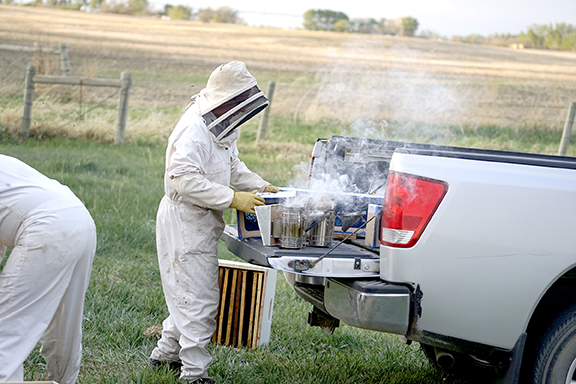Current Temperature
-13.8°C
Prairie Rose Honey buzzes into a good start
Posted on May 29, 2025 by Ryan Dahlman Courier/Commentator Photo Submitted by Samantha Johnson. HONEY PRODUCTION: Sheldon Hill smoking the bee packages prior to loading them into brood boxes.
Courier/Commentator Photo Submitted by Samantha Johnson. HONEY PRODUCTION: Sheldon Hill smoking the bee packages prior to loading them into brood boxes. By Samantha Johnson
Prairie Rose Public Schools Content Writer
Prairie Rose Public Schools is expanding into honey production and education this year. Eleven bee hives are being established at Neubauer Farms with plans to establish hives at several schools next year. Ten bee packages recently arrived from New Zealand and were loaded into brood boxes on Saturday night, May 10. The last hive was established using a swarm of bees master beekeeper Sheldon Hill rescued a week ago and donated to Prairie Rose Honey.
It took four days for the bee packages to reach Neubauer Farms, first on a plane from New Zealand to Vancouver and then driven into Alberta by Scandia Honey. As May 10 was an exceptionally hot day for early May, the bees could not be loaded into the brood boxes until the sun was setting and the temperature was starting to cool.
“The bees needed to come from New Zealand due to the heavy colony collapse sustained throughout Canada and the United States over the past winter, with some beekeepers losing up to 90 per cent of their bee colonies. The reason for the collapse is not yet fully understood,” stated Nichole Neubauer. “For that reason, there is high interest in importing bees from other countries as North American beekeepers will not have any extra bees to sell.”
This is a critical time for establishing the hives for Prairie Rose Honey, the bees need to be situated in the deep brood box and settle before the queen is released into the hive, which occurred three days after the bees were loaded. Hill and Neubauer will pull frames next week to determine if the queen is laying eggs.
“This is pivotal as the entire future of the bee colony revolves around the queen’s ability to lay lots of eggs, thousands and thousands of them,” explained Neubauer. “Once the hive is established, the queen starts filling frames with brood and capped brood.”
Capped brood are those eggs that have hatched into the larva stage – the bee life cycle is egg, larva, pupa and adult – and bees cap the hexagon of honeycomb until the larva matures and hatches out of the comb to join the hive.
“We need to see these bees increase their numbers so they can go out and forage to bring back pollen and nectar to the hive so they can ultimately make honey, said Neubauer.” The packages don’t contain a large number of bees, so it is important to give them every chance to be successful. Sheldon (Hill) will be feeding them simple syrup – a sugar and water mixture – in a free flow, nonstop supply until spring takes off and there is an abundance of flowering plants available.”
Currently, there are some early spring flowers available, primarily fruit trees and various shrubs, but bees require an incredible volume of flowers to make even a small amount of honey. Once the hives are well established and the bee colony has increased in numbers, a flow hive will be added on top of the brood boxes. Flow hives enable the extracting of honey without disturbing the bees as the hive doesn’t need to be dismantled to access the frames. Flow hives are designed to be placed directly on top of the brood box and will be the way Prairie Rose Honey is harvested this year.
Leave a Reply
You must be logged in to post a comment.

